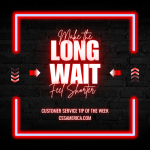Time is precious. There’s no time like the present. Your time is valuable. Timing is everything. Children spell “love,” T-I-M-E.
There are many great quotes that reference time. And part of the reason is that time can be considered somewhat finite; at least within the day, it’s a limited resource. What one person is doing will be just a step toward their next activity, their next conversation, their next trip that day.
So, what are ways that we can be considerate of the customer’s time?
The Schedule
- Give customers reasonable notice about when something from them is due, or a meeting will occur.
- Provide options so that if a time won’t work for them, they have alternatives to consider.
- Immediately let them know of schedule changes or cancellations.
The Prep and the Process
- Prepare going into the meeting so that the conversation is well-planned and can minimize the customer’s time.
- Start on time. End on time.
- Focus on the customer entirely during conversations, so that interruptions or unrelated activities don’t waste their time.
The Delay
- Ensure you’re well-trained on a process, so that the process isn’t delayed by lack of comfort, confidence, or knowledge in performing some standard activity.
- When they’re waiting, let them know the expectation for the wait time, see if there’s something they can be doing so that when the wait is over, they’ve already accomplished some of the next steps. Keep them informed and updated about when the wait will end.
- If there could be a lengthy delay or some research required, give the customer the option to exit the conversation, and offer to contact them once the research is complete.
Your time is valuable, and so is the customer’s time. Strengthen your strategies to ensure we’re considerate of the customer’s time.
Signup for FREE Tips! Contact Us More Resources for You Visit Our Home Page
























